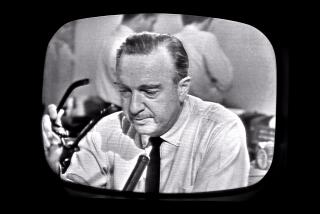TV AND THE GULF WAR : Bombing Alters the Good-News War
There it was--exactly what we didn’t want to see.
Suddenly Wednesday, the month-old Gulf War became a bloody, ugly mural of death on American television.
Yes, we had seen injuries and ambulances in Israel as that nation was hit by Iraqi missiles.
And we had seen those almost impersonal bombsight shots, through cross hairs, of explosives hitting some faraway Iraqi targets, with no human victims in sight.
This, after all, was the good-news TV war, nice and neat as censors controlled access to the horrible realities for military and security reasons.
But Wednesday morning changed all that.
There, as we ate breakfast and went to work, was a sickening TV landscape in which hundreds of people, most apparently civilians, had been killed in a Baghdad bunker by two pinpoint allied bombs.
The story may have been just as controlled as past coverage in the sense that Iraqi President Saddam Hussein clearly was using it as a powerful propaganda weapon--the biggest toll of civilians in the war, perhaps 500 dead.
It was precisely the kind of footage that U.S. officials, preparing for a possible ground war, didn’t want all over television because of the revulsion against killing and the negative impact it could have on public support for the conflict.
If only the Big Three networks--ABC, CBS and NBC--had carried the footage and details, the story, grisly and inflammatory as it was, might have had less impact than it did.
For the most part, until the nightly roundups, they limited coverage to brief reports on regular newscasts as the story broke--carrying their usual soap operas and game shows. It was a characteristic reaction.
And there was another factor:
Along with the death-filled images Wednesday, there was the immediate suspicion that Hussein was playing the tragedy for all its worth. American officials claimed that the bombed-out bunker was a military command post, not a civilian bomb shelter, and that Hussein was responsible for the civilians inside.
But Cable News Network, seen in about 60% of the nation’s homes, hammered home the magnitude of the bombing story--and the reaction--throughout the day with far more vivid coverage than the Big Three, as love scenes were being played out on the network soaps.
The pictures of Iraqis wailing, wounded and dead laid out in a courtyard, hit hard as they were shown again and again.
It all seemed a world apart from the comfortable, even good-humored briefings we have been getting daily on TV about how smoothly the war is going.
But by late afternoon, local TV was even broadcasting its routine sports roundups. Normal? Perhaps. But you wonder how TV would have played the story if American civilians had been killed in an air raid, by mistake or not.
As Bill Moyers has said on CNN, the Iraqi people are not the enemy--Hussein is. And even U.S. officials expressed outrage at the death of the victims who were allowed into a military installation that might be bombed.
But American TV viewers might have seen the war take a new, unpleasant turn politically as well. While a Saudi official said Hussein “was the one who killed the people,” Yemen’s ambassador to the United Nations was furious on the home screen, saying the deaths were “cold-blooded murder. . . . It’s carnage.”
So we see that even a TV industry that tries to protect us from an almost-instant satellite war cannot entirely prevent the terror from slipping through. But network officials said Wednesday they will still try to stop gruesome images from penetrating America’s living rooms, especially if a ground war occurs.
“A lot more graphic pictures came in Wednesday, but we have our standards of taste,” said David Miller, NBC director of foreign news. “We don’t want to offend the viewer. We don’t show decapitation or mutilation. We will not show the face of a dead GI that you could identify.”
At CNN, Ed Turner, executive vice president of news gathering, said, “This story is newsworthy because it adds bodies to the rubble, with major casualties, plus graphic pictures of Arab children, shot by CNN, not Iraq.”
At ABC, Walter Porges, vice president for news practices, added, “We don’t want to show somebody blown apart. If the camera person has done a good job, you have options. You can show wide shots, brief close-ups, without making people ill when they watch it.”
A primer on the face of war--TV-style.
More to Read
Sign up for Essential California
The most important California stories and recommendations in your inbox every morning.
You may occasionally receive promotional content from the Los Angeles Times.










